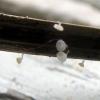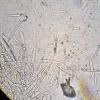
21-12-2025 09:32
Hello.A tiny ascomycete found embedded in wood in

22-12-2025 00:47
Patrice TANCHAUDBonsoir, récolte à proximité du milieu dunaire

21-12-2025 21:32
Pol DebaenstHello, Garden, Burgweg 19, Veurne, BelgiumOn 10/1

21-12-2025 21:40
Isabelle CharissouBonjour, j'aimerais connaitre les références de

21-12-2025 21:31
Pol DebaenstHello, Garden, Burgweg 19, Veurne, BelgiumOn 10/1

21-12-2025 21:31
Pol DebaenstHello, Garden, Burgweg 19, Veurne, BelgiumOn 10/1

20-12-2025 23:08
Patrice TANCHAUDBonsoir, récolte sur sol sablonneux dans l'arri�

20-12-2025 15:47
Mirek GrycHi.These grew on pine wood that was heavily covere
White oddity
Marja Pennanen,
27-05-2010 10:41
Marja Pennanen,
27-05-2010 10:49
Re:White oddity
This showed some facilities new to me in microscope.
I've never seen such paraphyses or hairs- meaning so big droplets.
The spores are 6-12x1-2, asci 33-40x4-5.
Lanceolate paraphyses are 4-5 micrometers wide and exceed the asci about 10-15 micrometers and have lots of droplets.
Hairs are 35-40x3-5 and they have droplets, too. Except at the stipe, where they are smaller, but can branch.
Strange, actually I have no idea even of the genus...
Marja
I've never seen such paraphyses or hairs- meaning so big droplets.
The spores are 6-12x1-2, asci 33-40x4-5.
Lanceolate paraphyses are 4-5 micrometers wide and exceed the asci about 10-15 micrometers and have lots of droplets.
Hairs are 35-40x3-5 and they have droplets, too. Except at the stipe, where they are smaller, but can branch.
Strange, actually I have no idea even of the genus...
Marja
Enrique Rubio,
27-05-2010 10:51
Re:White oddity
Its a Lachnum (Dasyscyphus) species, probably L. pudicellum
Enrique
Enrique
Hans-Otto Baral,
27-05-2010 10:56

Re:White oddity
Yes, I agree. The hairs are surely warted. The droplets inside and in the paraphyses are VBs (vacuolar bodies), they are responsible for the colour change to red-brown in the dead state. Such a fungus may look deep brown when dry. If you add KOH these droplets disappear.
Zotto
Zotto
Marja Pennanen,
27-05-2010 11:17
Re:White oddity
Hello,
thanks. One of the synonyms seems to be L. tenuissimum and I've allready found that.
With another microscope things seems different ;)
Marja
thanks. One of the synonyms seems to be L. tenuissimum and I've allready found that.
With another microscope things seems different ;)
Marja


